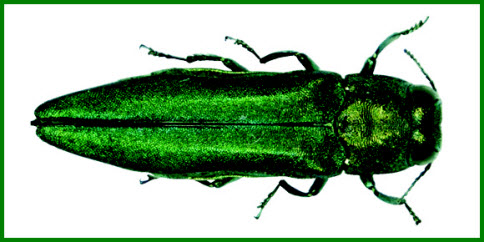It’s making its way across Canada and has finally reached Winnipeg, travelling up from Minnesota. We are talking about the dreaded emerald ash borer, the imported, pretty, green jewel beetle that is devastating ash trees, particularly green ash, across central Canada and the U.S. It does not affect mountain ash.
Its Latin name is Agrilus planipennis and it arrived in Canada via Windsor in 2002. Since then, it has moved into Ontario and Quebec and hit Toronto in 2007 killing thousands of ash trees.
The beetle is about a half-inch long and an eighth of an inch wide. Its slender body is a metallic green in colour. The larvae are flat and white and an inch long.
The adult beetle, which is a flyer, feeds on leaves and then bores into the cracks in the bark of the tree to the cambium layer where it lays its eggs from June to August. The larva hatch and feed on the inner bark, creating tunnels that cut off water and nutrient flow in the tree and causing affected branches to die.
The damage starts in the crown which will exhibit thinning and dieback. Notches that look like bites out of the leaf will appear on an attacked tree and as time progresses you may see frass on these more severely eaten leaves. You might see sprouting of new branches in the lower part of three tree. Trees under attack will also send out heavy seed crops and foliage will yellow early.
To protect your trees, look for bark splitting and borer holes, which are D-shaped and about one-eighth inch across. If you peel back the bark, you will see the S-shaped larva galleries.
In Ontario, the only product used to treat infected ash trees is TreeAzin, a neem derivative. This is also being heavily marketed in Manitoba. Injections are expensive and must be repeated several times every two or three years but most trees up to one-third impacted can be saved. An average single treatment costs between $200 and $300, but can go as high as $700 depending on the size of the tree.
Imidacloprid is a nicotinoid that is still in use in Quebec and Western Canada where it is used in crop management but it is likely that it will be phased out as early as next December, 2018 over concern about detrimental effects on fish and wild birds.
It is also injected in trees but has sometimes used as a soil drench around the roots of the tree. It can take up to two months for the product to reach the crown of a tree.
All about TreeAzin and neem
To date in Ontario, the only remedy is a product called TreeAzin, derived from neem tree seeds. Apparently, TreeAzin is the extract of a particular chemical, azadirachtin, which is known to be effective against about 200 insects by interrupting feeding and growth.
This chemical has been registered by Health Canada as a pesticide to the company, BioForest Technologies Inc. which is owned by the Canadian Forest Service.
Because Health Canada issued a number of cease and desist orders a few years ago to people who were selling neem products as a product to combat the red lily leaf beetle, confusion developed over its legality in Canada. Now Health Canada says that neem oil is in itself not a banned product. It can be purchased and sold in Canada but it is not to be commercially used as an insecticide – nor is it to be sold as a leaf shine (no explanation why). The only neem product registered as a pesticide in this country is TreeAzin.
It is sold through professional tree services along with an injection method that introduces the product directly to the xylem system of the tree, where it kills eggs and larvae and systemically enters the leaves to kill the feeding beetle itself.
What is neem oil?
According to Wikipedia, neem oil contains a number of compounds additional to azadirachtin known to deter both insects and fungus. When used to deter insects, including bed bugs, raw neem oil is mixed at a rate of one ounce to one gallon of water and it usually also needs an emulsifier such as a teaspoon of detergent to help the oil and water mix.
Neem cake is used as a fertilizer. In addition to containing NPK, it also has a long list of essential micro nutrients and protects plants from harmful nematodes and grubs.
Neem breaks down quickly in the environment leaving no residual harmful chemicals.



